As per Intent Market Research, the Synthetic Fuels Market was valued at USD 5.1 billion in 2023-e and will surpass USD 15.8 billion by 2030; growing at a CAGR of 19.3% during 2024 - 2030. Growing global concerns about greenhouse gas emissions and climate change are increasing the focus on synthetic fuels as a greener energy option.
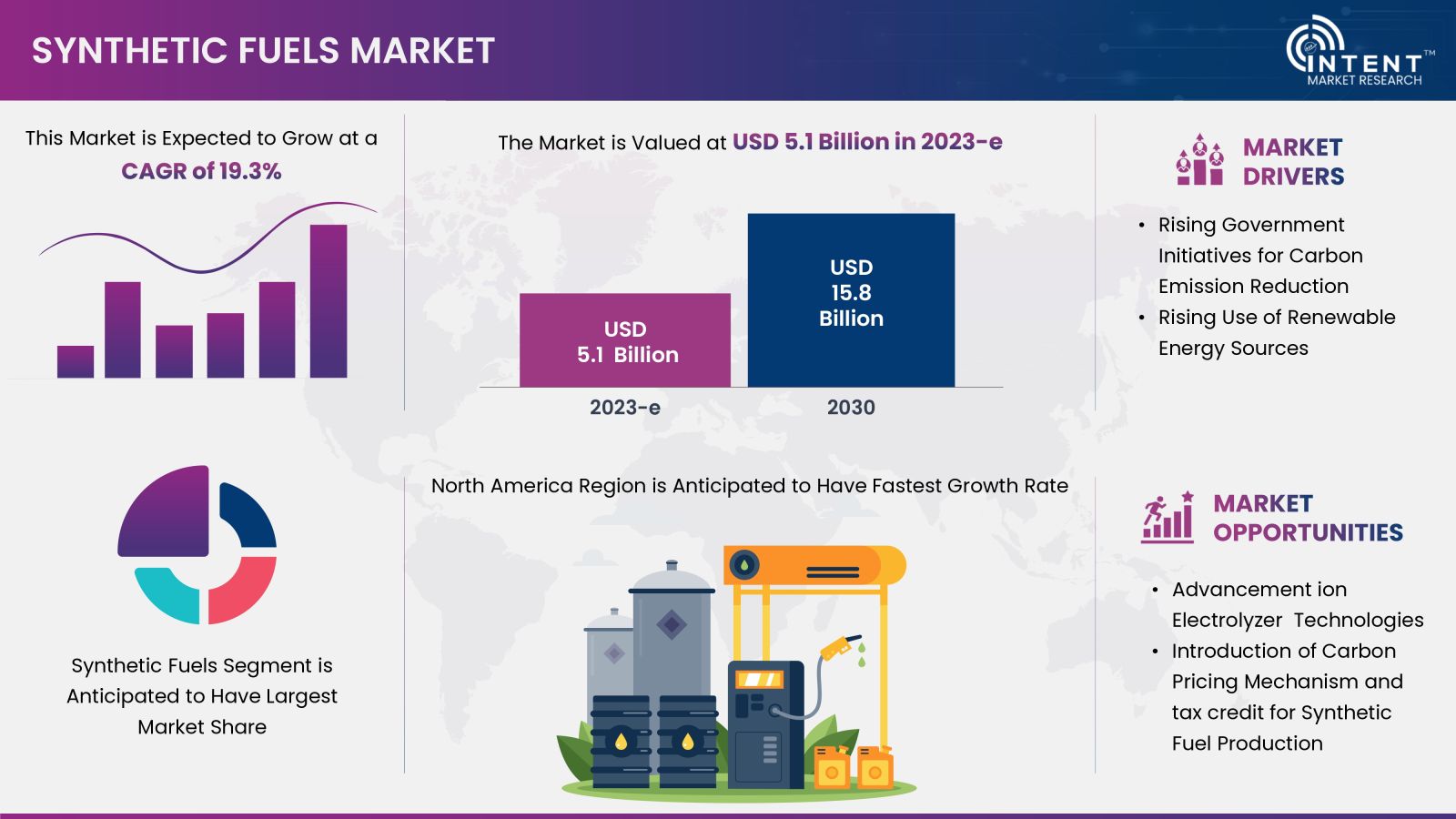
Synthetic fuels i.e. synfuels or alternative fuels, are fuels produced from renewable or non-renewable resources through chemical processes. Synthetic fuels are created through various methods such as gasification, Fischer-Tropsch synthesis, or biological processes. These fuels are compatible with existing infrastructure and combustion engines. Common examples include synthetic gasoline, diesel, and jet fuel derived from sources such as biomass, natural gas, or even carbon dioxide captured from the atmosphere.
Synthetic Fuels Market Dynamics
Rising Government Initiatives for Carbon Emission Reduction are Driving the Synthetic Fuels Market
Governments and organizations around the world are setting ambitious goals to reduce carbon emissions and combat climate change. Synthetic fuels offer an opportunity to decarbonize sectors that are difficult to electrify directly, such as aviation, heavy industry, and long-haul shipping. For example, the U.S. Council on Environmental Quality (CEQ) launched the Global Net-Zero Government Initiative on November 17, 2022, joining the United States with 18 countries to reduce emissions from government activities. Countries participating in this initiative commit to achieving net-zero emissions from national government operations by 2050 at the latest. These initiatives are driving the market growth over the forecast period.
However, the production of synthetic fuels, especially by processes such as electrolysis, is energy-intensive and expensive. Synthetic fuels are often more expensive to produce than traditional fossil fuels, which limits the synthetic fuel market growth.
Technological Advancements are Offering a Lucrative Growth Opportunity for the Synthetic Fuels Market
Continuing research and development in electrolysis, catalysis, and other technologies lead to more efficient and cost-effective methods of producing synthetic fuels. Advances in materials science and process optimization reduce production costs and improve overall energy efficiency. For example, in January 2022, the US Department of Energy implemented the H2@Scale vision, with a clean hydrogen target of USD 1 per kg of hydrogen shot.
Synthetic Fuels Market Segment Insights
Rising Demand for MTG Process in Transportation Sector is Fueling the Synthetic Fuels Market
The methanol-to-gasoline (MTG) process has gained attention for its major role in transportation sector. As the transportation sector seeks cleaner and more sustainable alternatives to traditional gasoline, the production of synthetic gasoline through the MTG process addresses this demand, contributing to the growth of the synthetic fuel market. In summary, the Methanol to Gasoline (MTG) segment's prominence in the synthetic fuel market is driven by factors such as feedstock availability, the quality of the end product, compatibility with existing infrastructure, technical maturity, scalability, and alignment with environmental and market demands.
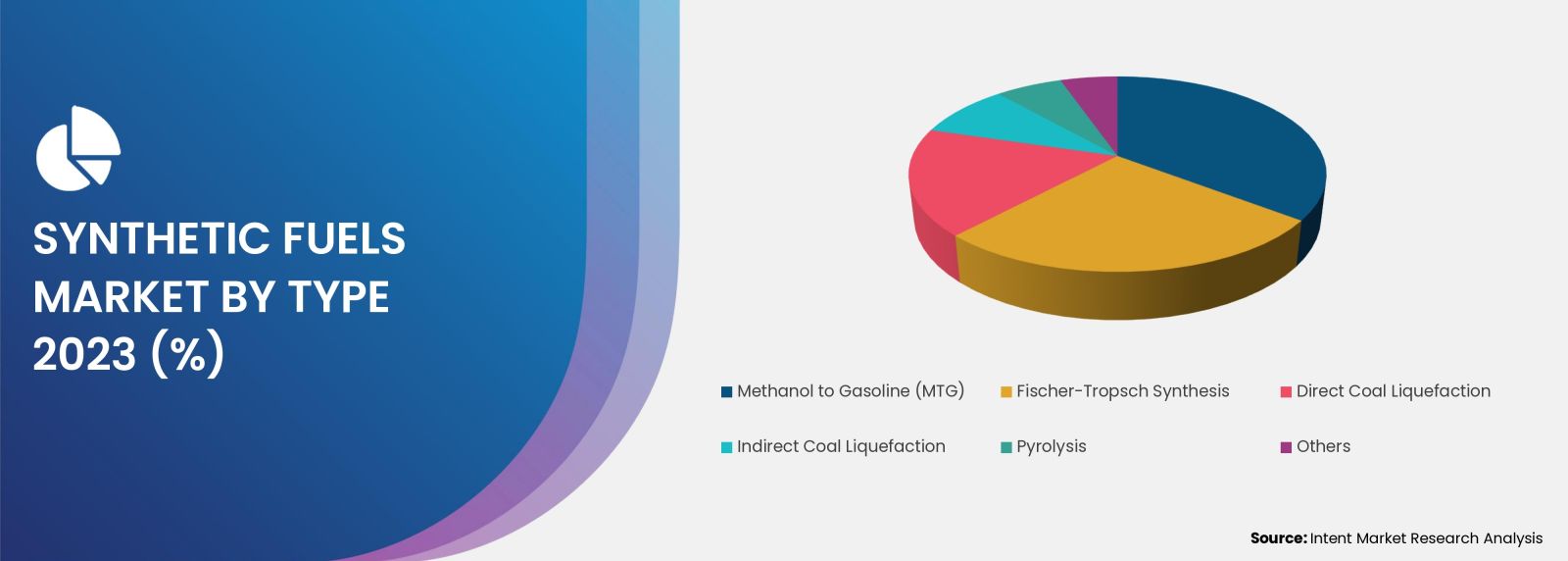
Demand for Natural Gas Is Rising Owing to Its Cost-Competitive Nature
Natural gas is widely used as a feedstock for synthetic fuel production as its cost competitive as comapred to other feedstocks. The production of synthetic fuels from natural gas offers opportunities for carbon capture and utilization (CCU). Natural gas is a source of hydrogen, which is a key component in many synthetic fuel production processes. Natural gas-based synthetic fuel production is combined with carbon capture technologies to create a closed carbon loop.
Synthetic Fuels Are Widely Deployed in Chemical Sector Due to Lower Carbon Emissions
Synthetic fuels are used as feedstocks for the synthesis of methanol. Methanol is a building block for various chemicals and is used in the production of plastics, resins, and solvents. Synthetic fuels undergo processes such as steam cracking to produce olefins, such as ethylene and propylene.
Olefins are essential building blocks for the production of polymers and plastics. Hydrogen is a versatile chemical feedstock used in the production of ammonia, methanol, and various other chemicals. The deployment of synthetic fuels in the chemical industry is driven by the desire to reduce reliance on traditional fossil fuel feedstocks, lower carbon emissions, and enhance overall sustainability.
Regional Insights
Availability of Raw Materials is driving the North America Synthetic Fuel Market Growth
North America is the largest synthetic fuels market having a major global market share in 2023 due to the high demand for synthetic fuels from the transportation sector and the availability of raw materials and production infrastructure. The regional growth is also driven by government initiatives such as carbon pricing and emissions reduction targets.
Competitive landscape
Key Players are Expanding their Solution Portfolio to Sustain in the Competitive Environment
Manufacturers are pursuing various strategies such as acquisitions, mergers, joint ventures, and geographic expansion to increase market penetration and respond to the changing technology needs of various end-use industries. For instance, in 2022, ExxonMobil acquired Clean Energy Fuels which will assist ExxonMobil to expand its presence in the renewable fuels market.
Some prominent players in the global synthetic fuels market are Chevron Renewable Energy Group, Chn Energy Investment Group, Dakota Gasification Company, ExxonMobil, Inner Mongolia Yitai Coal, Linde, Maire Tecnimont, Neste, Norsk E-Fuel, Petro SA, Prometheus Fuels, QatarEnergy, Shell, TotalEnergies, Virent.
Synthetic Fuels Market Coverage
The report provides key insights into the synthetic fuels market, and it focuses on technological developments, trends, and initiatives taken by the government in this sector. The analysis focuses on market drivers, restraints, and opportunities, and examines key players and the competitive landscape within the synthetic fuels market.

Report Scope
|
Report Features |
Description |
|
Market Size (2023-e) |
USD 5.1 billion |
|
Forecast Revenue (2030) |
USD 15.8 billion |
|
CAGR (2024-2030) |
19.3% |
|
Base Year for Estimation |
2023-e |
|
Historic Year |
2022 |
|
Forecast Period |
2024-2030 |
|
Report Coverage |
Revenue Forecast, Market Dynamics, Competitive Landscape, Recent Developments |
|
Segments Covered |
By Production Technology (Methanol to Gasoline (MTG), Fischer-Tropsch Synthesis, Direct Coal Liquefaction, Indirect Coal Liquefaction, Pyrolysis & Others), By End-Use Applications (Transportation Fuels, Chemicals, Power Generation, Residential Heating, and others), By Feedstock (Biomass-Based Synfuels, Natural Gas-Based Synfuels, Carbon Capture and Utilization (CCU) Synfuels & Others) |
|
Regional Analysis |
North America (US, Canada), Europe (Germany, France, UK, Spain, Italy), Asia-Pacific (China, Japan, South Korea, India), Latin America (Brazil, Mexico, Argentina), Middle East & Africa (Saudi Arabia, South Africa, Turkey, United Arab Emirates) |
|
Competitive Landscape |
Chevron Renewable Energy Group, Chn Energy Investment Group, Dakota Gasification Company, ExxonMobil, Inner Mongolia Yitai Coal, Linde, Maire Tecnimont, Neste, Norsk E-Fuel, Petro SA, Prometheus Fuels, QatarEnergy, Shell, TotalEnergies, and Virent |
|
Customization Scope |
Customization for segments, region/country-level will be provided. Moreover, additional customization can be done based on the requirements |
|
Purchase Options |
We have three licenses to opt for Single User License, Multi-User License (Up to 5 Users), Corporate Use License (Unlimited User and Printable PDF) |
|
1. Introduction |
|
1. 1. Study Assumptions and Synthetic Fuels Market Definition |
|
1.2. Scope of the Study |
|
2. Research Methodology |
|
3. Executive Summary |
|
4. Synthetic Fuels Market Dynamics |
|
4.1. Market Growth Drivers |
|
4.2 Market Growth Challenges |
|
5. Synthetic Fuels Market Outlook |
|
5.1. Technological Advancements |
|
5.2 Regulatory Framework |
|
5.3. Patent Analysis |
|
5.4. PESTLE Analysis |
|
5.5. PORTER’s Five Forces Analysis |
|
5.6. Pricing Analysis |
|
5.7. Production Analysis |
|
5.8. Pandemic Impact on Synthetic Fuel Market |
|
5.9. Investment & Funding Analysis |
|
6. Global Synthetic Fuels Market Segmentation (Market Size & Forecast: USD Billion, 2024 – 2030) |
|
6.1 Production Technology |
|
6.1.1 Methanol to Gasoline (MTG) |
|
6.1.2 Fischer-Tropsch Synthesis |
|
6.1.3 Direct Coal Liquefaction |
|
6.1.4 Indirect Coal Liquefaction |
|
6.1.5 Pyrolysis |
|
6.1.6 Others |
|
6.2 End-Use Applications |
|
6.2.1 Transportation Fuels |
|
6.2.2 Chemicals |
|
6.2.3 Power Generation |
|
6.2.4 Residential Heating |
|
6.2.5 Others |
|
6.3 Feedstock |
|
6.3.1 Biomass-Based Synfuels |
|
6.3.2 Natural Gas-Based Synfuels |
|
6.3.3 Carbon Capture and Utilization (CCU) Synfuels |
|
6.3.4 Others |
|
6.4 Geography |
|
6.4.1 North America |
|
6.4.2 Europe |
|
6.4.3 Asia-Pacific |
|
6.4.4 Latin America |
|
6.4.5 Middle East and Africa |
|
7. North America Synthetic Fuels Market Segmentation (Market Size & Forecast: USD Billion, 2024 – 2030) |
|
7.1 Production Technology |
|
7.1.1 Methanol to Gasoline (MTG) |
|
7.1.2 Fischer-Tropsch Synthesis |
|
7.1.3 Direct Coal Liquefaction |
|
7.1.4 Indirect Coal Liquefaction |
|
7.1.5 Pyrolysis |
|
7.1.7 Others |
|
7.2 End-Use Applications |
|
7.2.1 Transportation Fuels |
|
7.2.2 Chemicals |
|
7.2.3 Power Generation |
|
7.2.4 Residential Heating |
|
7.2.5 Others |
|
7.3 Feedstock |
|
7.3.1 Biomass-Based Synfuels |
|
7.3.2 Natural Gas-Based Synfuels |
|
7.3.3 Carbon Capture and Utilization (CCU) Synfuels |
|
7.3.4 Others |
|
7.4 Country |
|
7.4.1 United States |
|
7.4.1.1 Production Technology |
|
7.4.1.1.1 Methanol to Gasoline (MTG) |
|
7.4.1.1.2 Fischer-Tropsch Synthesis |
|
7.4.1.1.3 Direct Coal Liquefaction |
|
7.4.1.1.4 Indirect Coal Liquefaction |
|
7.4.1.1.5 Pyrolysis |
|
7.4.1.1.6 Others |
|
7.4.1.2 End-Use Applications |
|
7.4.1.2.1 Medical |
|
7.4.1.2.2 Consumer Electronics |
|
7.4.1.2.3 Residential Heating |
|
7.4.1.2.4 Chemicals |
|
7.4.1.2.5 Others |
|
7.4.1.3 Feedstock |
|
7.4.1.3.1 Biomass-Based Synfuels |
|
7.4.1.3.2 Natural Gas-Based Synfuels |
|
7.4.1.3.3 Carbon Capture and Utilization (CCU) Synfuels |
|
7.4.1.3.4 Others |
|
7.4.2 Canada |
|
7.4.2.1 Production Technology |
|
7.4.2.1.1 Methanol to Gasoline (MTG) |
|
7.4.2.1.2 Fischer-Tropsch Synthesis |
|
7.4.2.1.3 Direct Coal Liquefaction |
|
7.4.2.1.4 Indirect Coal Liquefaction |
|
7.4.2.1.5 Pyrolysis |
|
7.4.2.1.6 Others |
|
7.4.2.2 End-Use Applications |
|
7.4.2.2.1 Medical |
|
7.4.2.2.2 Consumer Electronics |
|
7.4.2.2.3 Residential Heating |
|
7.4.2.2.4 Chemicals |
|
7.4.2.2.5 Others |
|
7.4.2.3 Feedstock |
|
7.4.2.3.1 Biomass-Based Synfuels |
|
7.4.2.3.2 Natural Gas-Based Synfuels |
|
7.4.2.3.3 Carbon Capture and Utilization (CCU) Synfuels |
|
7.4.2.3.4 Others |
|
8. Europe Market Synthetic Fuels Segmentation (Market Size & Forecast: USD Billion, 2024 – 2030) |
|
8.1 Production Technology |
|
8.1.1 Methanol to Gasoline (MTG) |
|
8.1.2 Fischer-Tropsch Synthesis |
|
8.1.3 Direct Coal Liquefaction |
|
8.1.4 Indirect Coal Liquefaction |
|
8.1.5 Pyrolysis |
|
8.1.8 Others |
|
8.2 End-Use Applications |
|
8.2.1 Transportation Fuels |
|
8.2.2 Chemicals |
|
8.2.3 Power Generation |
|
8.2.4 Residential Heating |
|
8.2.5 Others |
|
8.3 Feedstock |
|
8.3.1 Biomass-Based Synfuels |
|
8.3.2 Natural Gas-Based Synfuels |
|
8.3.3 Carbon Capture and Utilization (CCU) Synfuels |
|
8.3.4 Others |
|
8.4 Country |
|
8.4.1 United Kingdom |
|
8.4.1.1 Production Technology |
|
8.4.1.1.1 Methanol to Gasoline (MTG) |
|
8.4.1.1.2 Fischer-Tropsch Synthesis |
|
8.4.1.1.3 Direct Coal Liquefaction |
|
8.4.1.1.4 Indirect Coal Liquefaction |
|
8.4.1.1.5 Pyrolysis |
|
8.4.1.1.6 Others |
|
8.4.1.2 End-Use Applications |
|
8.4.1.2.1 Medical |
|
8.4.1.2.2 Consumer Electronics |
|
8.4.1.2.3 Residential Heating |
|
8.4.1.2.4 Chemicals |
|
8.4.1.2.5 Others |
|
8.4.1.3 Feedstock |
|
8.4.1.3.1 Biomass-Based Synfuels |
|
8.4.1.3.2 Natural Gas-Based Synfuels |
|
8.4.1.3.3 Carbon Capture and Utilization (CCU) Synfuels |
|
8.4.1.3.4 Others |
|
8.4.2 France |
|
8.4.2.1 Production Technology |
|
8.4.2.1.1 Methanol to Gasoline (MTG) |
|
8.4.2.1.2 Fischer-Tropsch Synthesis |
|
8.4.2.1.3 Direct Coal Liquefaction |
|
8.4.2.1.4 Indirect Coal Liquefaction |
|
8.4.2.1.5 Pyrolysis |
|
8.4.2.1.6 Others |
|
8.4.2.2 End-Use Applications |
|
8.4.2.2.1 Medical |
|
8.4.2.2.2 Consumer Electronics |
|
8.4.2.2.3 Residential Heating |
|
8.4.2.2.4 Chemicals |
|
8.4.2.2.5 Others |
|
8.4.2.3 Feedstock |
|
8.4.2.3.1 Biomass-Based Synfuels |
|
8.4.2.3.2 Natural Gas-Based Synfuels |
|
8.4.2.3.3 Carbon Capture and Utilization (CCU) Synfuels |
|
8.4.2.3.4 Others |
|
8.4.3 Germany |
|
8.4.3.1 Production Technology |
|
8.4.3.1.1 Methanol to Gasoline (MTG) |
|
8.4.3.1.2 Fischer-Tropsch Synthesis |
|
8.4.3.1.3 Direct Coal Liquefaction |
|
8.4.3.1.4 Indirect Coal Liquefaction |
|
8.4.3.1.5 Pyrolysis |
|
8.4.3.1.6 Others |
|
8.4.3.2 End-Use Applications |
|
8.4.3.2.1 Medical |
|
8.4.3.2.2 Consumer Electronics |
|
8.4.3.2.3 Residential Heating |
|
8.4.3.2.4 Chemicals |
|
8.4.3.2.5 Others |
|
8.4.3.3 Feedstock |
|
8.4.3.3.1 Biomass-Based Synfuels |
|
8.4.3.3.2 Natural Gas-Based Synfuels |
|
8.4.3.3.3 Carbon Capture and Utilization (CCU) Synfuels |
|
8.4.3.3.4 Others |
|
8.4.4 Italy |
|
8.4.4.1 Production Technology |
|
8.4.4.1.1 Methanol to Gasoline (MTG) |
|
8.4.4.1.2 Fischer-Tropsch Synthesis |
|
8.4.4.1.3 Direct Coal Liquefaction |
|
8.4.4.1.4 Indirect Coal Liquefaction |
|
8.4.4.1.5 Pyrolysis |
|
8.4.4.1.6 Others |
|
8.4.4.2 End-Use Applications |
|
8.4.4.2.1 Medical |
|
8.4.4.2.2 Consumer Electronics |
|
8.4.4.2.3 Residential Heating |
|
8.4.4.2.4 Chemicals |
|
8.4.4.2.5 Others |
|
8.4.4.3 Feedstock |
|
8.4.4.3.1 Biomass-Based Synfuels |
|
8.4.4.3.2 Natural Gas-Based Synfuels |
|
8.4.4.3.3 Carbon Capture and Utilization (CCU) Synfuels |
|
8.4.4.3.4 Others |
|
9. Asia Pacific Synthetic Fuels Market Segmentation (Market Size & Forecast: USD Billion, 2024 – 2030) |
|
9.1 Production Technology |
|
9.1.1 Methanol to Gasoline (MTG) |
|
9.1.2 Fischer-Tropsch Synthesis |
|
9.1.3 Direct Coal Liquefaction |
|
9.1.4 Indirect Coal Liquefaction |
|
9.1.5 Pyrolysis |
|
9.1.9 Others |
|
9.2 End-Use Applications |
|
9.2.1 Transportation Fuels |
|
9.2.2 Chemicals |
|
9.2.3 Power Generation |
|
9.2.4 Residential Heating |
|
9.2.5 Others |
|
9.3 Feedstock |
|
9.3.1 Biomass-Based Synfuels |
|
9.3.2 Natural Gas-Based Synfuels |
|
9.3.3 Carbon Capture and Utilization (CCU) Synfuels |
|
9.3.4 Others |
|
9.4 Country |
|
9.4.1 China |
|
9.4.1.1 Production Technology |
|
9.4.1.1.1 Methanol to Gasoline (MTG) |
|
9.4.1.1.2 Fischer-Tropsch Synthesis |
|
9.4.1.1.3 Direct Coal Liquefaction |
|
9.4.1.1.4 Indirect Coal Liquefaction |
|
9.4.1.1.5 Pyrolysis |
|
9.4.1.1.6 Others |
|
9.4.1.2 End-Use Applications |
|
9.4.1.2.1 Medical |
|
9.4.1.2.2 Consumer Electronics |
|
9.4.1.2.3 Residential Heating |
|
9.4.1.2.4 Chemicals |
|
9.4.1.2.5 Others |
|
9.4.1.3 Feedstock |
|
9.4.1.3.1 Biomass-Based Synfuels |
|
9.4.1.3.2 Natural Gas-Based Synfuels |
|
9.4.1.3.3 Carbon Capture and Utilization (CCU) Synfuels |
|
9.4.1.3.4 Others |
|
9.4.2 Japan |
|
9.4.2.1 Production Technology |
|
9.4.2.1.1 Methanol to Gasoline (MTG) |
|
9.4.2.1.2 Fischer-Tropsch Synthesis |
|
9.4.2.1.3 Direct Coal Liquefaction |
|
9.4.2.1.4 Indirect Coal Liquefaction |
|
9.4.2.1.5 Pyrolysis |
|
9.4.2.1.6 Others |
|
9.4.2.2 End-Use Applications |
|
9.4.2.2.1 Medical |
|
9.4.2.2.2 Consumer Electronics |
|
9.4.2.2.3 Residential Heating |
|
9.4.2.2.4 Chemicals |
|
9.4.2.2.5 Others |
|
9.4.2.3 Feedstock |
|
9.4.2.3.1 Biomass-Based Synfuels |
|
9.4.2.3.2 Natural Gas-Based Synfuels |
|
9.4.2.3.3 Carbon Capture and Utilization (CCU) Synfuels |
|
9.4.2.3.4 Others |
|
9.4.3 India |
|
9.4.3.1 Production Technology |
|
9.4.3.1.1 Methanol to Gasoline (MTG) |
|
9.4.3.1.2 Fischer-Tropsch Synthesis |
|
9.4.3.1.3 Direct Coal Liquefaction |
|
9.4.3.1.4 Indirect Coal Liquefaction |
|
9.4.3.1.5 Pyrolysis |
|
9.4.3.1.6 Others |
|
9.4.3.2 End-Use Applications |
|
9.4.3.2.1 Medical |
|
9.4.3.2.2 Consumer Electronics |
|
9.4.3.2.3 Residential Heating |
|
9.4.3.2.4 Chemicals |
|
9.4.3.2.5 Others |
|
9.4.3.3 Feedstock |
|
9.4.3.3.1 Biomass-Based Synfuels |
|
9.4.3.3.2 Natural Gas-Based Synfuels |
|
9.4.3.3.3 Carbon Capture and Utilization (CCU) Synfuels |
|
9.4.3.3.4 Others |
|
9.4.4 South Korea |
|
9.4.4.1 Production Technology |
|
9.4.4.1.1 Methanol to Gasoline (MTG) |
|
9.4.4.1.2 Fischer-Tropsch Synthesis |
|
9.4.4.1.3 Direct Coal Liquefaction |
|
9.4.4.1.4 Indirect Coal Liquefaction |
|
9.4.4.1.5 Pyrolysis |
|
9.4.4.1.6 Others |
|
9.4.4.2 End-Use Applications |
|
9.4.4.2.1 Medical |
|
9.4.4.2.2 Consumer Electronics |
|
9.4.4.2.3 Residential Heating |
|
9.4.4.2.4 Chemicals |
|
9.4.4.2.5 Others |
|
9.4.4.3 Feedstock |
|
9.4.4.3.1 Biomass-Based Synfuels |
|
9.4.4.3.2 Natural Gas-Based Synfuels |
|
9.4.4.3.3 Carbon Capture and Utilization (CCU) Synfuels |
|
9.4.4.3.4 Others |
|
10. Latin America Synthetic Fuels Market Segmentation (Market Size & Forecast: USD Billion, 2024 – 2030) |
|
10.1 Production Technology |
|
10.1.1 Methanol to Gasoline (MTG) |
|
10.1.2 Fischer-Tropsch Synthesis |
|
10.1.3 Direct Coal Liquefaction |
|
10.1.4 Indirect Coal Liquefaction |
|
10.1.5 Pyrolysis |
|
10.1.10 Others |
|
10.2 End-Use Applications |
|
10.2.1 Transportation Fuels |
|
10.2.2 Chemicals |
|
10.2.3 Power Generation |
|
10.2.4 Residential Heating |
|
10.2.5 Others |
|
10.3 Feedstock |
|
10.3.1 Biomass-Based Synfuels |
|
10.3.2 Natural Gas-Based Synfuels |
|
10.3.3 Carbon Capture and Utilization (CCU) Synfuels |
|
10.3.4 Others |
|
10.4 Country |
|
10.4.1 Brazil |
|
10.4.1.1 Production Technology |
|
10.4.1.1.1 Methanol to Gasoline (MTG) |
|
10.4.1.1.2 Fischer-Tropsch Synthesis |
|
10.4.1.1.3 Direct Coal Liquefaction |
|
10.4.1.1.4 Indirect Coal Liquefaction |
|
10.4.1.1.5 Pyrolysis |
|
10.4.1.1.6 Others |
|
10.4.1.2 End-Use Applications |
|
10.4.1.2.1 Medical |
|
10.4.1.2.2 Consumer Electronics |
|
10.4.1.2.3 Residential Heating |
|
10.4.1.2.4 Chemicals |
|
10.4.1.2.5 Others |
|
10.4.1.3 Feedstock |
|
10.4.1.3.1 Biomass-Based Synfuels |
|
10.4.1.3.2 Natural Gas-Based Synfuels |
|
10.4.1.3.3 Carbon Capture and Utilization (CCU) Synfuels |
|
10.4.1.3.4 Others |
|
10.4.2 Mexico |
|
10.4.2.1 Production Technology |
|
10.4.2.1.1 Methanol to Gasoline (MTG) |
|
10.4.2.1.2 Fischer-Tropsch Synthesis |
|
10.4.2.1.3 Direct Coal Liquefaction |
|
10.4.2.1.4 Indirect Coal Liquefaction |
|
10.4.2.1.5 Pyrolysis |
|
10.4.2.1.6 Others |
|
10.4.2.2 End-Use Applications |
|
10.4.2.2.1 Medical |
|
10.4.2.2.2 Consumer Electronics |
|
10.4.2.2.3 Residential Heating |
|
10.4.2.2.4 Chemicals |
|
10.4.2.2.5 Others |
|
10.4.2.3 Feedstock |
|
10.4.2.3.1 Biomass-Based Synfuels |
|
10.4.2.3.2 Natural Gas-Based Synfuels |
|
10.4.2.3.3 Carbon Capture and Utilization (CCU) Synfuels |
|
10.4.2.3.4 Others |
|
10.4.3 Argentina |
|
10.4.3.1 Production Technology |
|
10.4.3.1.1 Methanol to Gasoline (MTG) |
|
10.4.3.1.2 Fischer-Tropsch Synthesis |
|
10.4.3.1.3 Direct Coal Liquefaction |
|
10.4.3.1.4 Indirect Coal Liquefaction |
|
10.4.3.1.5 Pyrolysis |
|
10.4.3.1.6 Others |
|
10.4.3.2 End-Use Applications |
|
10.4.3.2.1 Medical |
|
10.4.3.2.2 Consumer Electronics |
|
10.4.3.2.3 Residential Heating |
|
10.4.3.2.4 Chemicals |
|
10.4.3.2.5 Others |
|
10.4.3.3 Feedstock |
|
10.4.3.3.1 Biomass-Based Synfuels |
|
10.4.3.3.2 Natural Gas-Based Synfuels |
|
10.4.3.3.3 Carbon Capture and Utilization (CCU) Synfuels |
|
10.4.3.3.4 Others |
|
11. Middle East & Africa Synthetic Fuels Market Segmentation (Market Size & Forecast: USD Billion, 2024 – 2030) |
|
11.1 Production Technology |
|
11.1.1 Methanol to Gasoline (MTG) |
|
11.1.2 Fischer-Tropsch Synthesis |
|
11.1.3 Direct Coal Liquefaction |
|
11.1.4 Indirect Coal Liquefaction |
|
11.1.5 Pyrolysis |
|
11.1.11 Others |
|
11.2 End-Use Applications |
|
11.2.1 Transportation Fuels |
|
11.2.2 Chemicals |
|
11.2.3 Power Generation |
|
11.2.4 Residential Heating |
|
11.2.5 Others |
|
11.3 Feedstock |
|
11.3.1 Biomass-Based Synfuels |
|
11.3.2 Natural Gas-Based Synfuels |
|
11.3.3 Carbon Capture and Utilization (CCU) Synfuels |
|
11.3.4 Others |
|
11.4 Country |
|
11.4.1 Saudi Arabia |
|
11.4.1.1 Production Technology |
|
11.4.1.1.1 Methanol to Gasoline (MTG) |
|
11.4.1.1.2 Fischer-Tropsch Synthesis |
|
11.4.1.1.3 Direct Coal Liquefaction |
|
11.4.1.1.4 Indirect Coal Liquefaction |
|
11.4.1.1.5 Pyrolysis |
|
11.4.1.1.6 Others |
|
11.4.1.2 End-Use Applications |
|
11.4.1.2.1 Medical |
|
11.4.1.2.2 Consumer Electronics |
|
11.4.1.2.3 Residential Heating |
|
11.4.1.2.4 Chemicals |
|
11.4.1.2.5 Others |
|
11.4.1.3 Feedstock |
|
11.4.1.3.1 Biomass-Based Synfuels |
|
11.4.1.3.2 Natural Gas-Based Synfuels |
|
11.4.1.3.3 Carbon Capture and Utilization (CCU) Synfuels |
|
11.4.1.3.4 Others |
|
11.4.2 South Africa |
|
11.4.2.1 Production Technology |
|
11.4.2.1.1 Methanol to Gasoline (MTG) |
|
11.4.2.1.2 Fischer-Tropsch Synthesis |
|
11.4.2.1.3 Direct Coal Liquefaction |
|
11.4.2.1.4 Indirect Coal Liquefaction |
|
11.4.2.1.5 Pyrolysis |
|
11.4.2.1.6 Others |
|
11.4.2.2 End-Use Applications |
|
11.4.2.2.1 Medical |
|
11.4.2.2.2 Consumer Electronics |
|
11.4.2.2.3 Residential Heating |
|
11.4.2.2.4 Chemicals |
|
11.4.2.2.5 Others |
|
11.4.2.3 Feedstock |
|
11.4.2.3.1 Biomass-Based Synfuels |
|
11.4.2.3.2 Natural Gas-Based Synfuels |
|
11.4.2.3.3 Carbon Capture and Utilization (CCU) Synfuels |
|
11.4.2.3.4 Others |
|
11.4.3 United Arab Emirates |
|
11.4.3.1 Production Technology |
|
11.4.3.1.1 Methanol to Gasoline (MTG) |
|
11.4.3.1.2 Fischer-Tropsch Synthesis |
|
11.4.3.1.3 Direct Coal Liquefaction |
|
11.4.3.1.4 Indirect Coal Liquefaction |
|
11.4.3.1.5 Pyrolysis |
|
11.4.3.1.6 Others |
|
11.4.3.2 End-Use Applications |
|
11.4.3.2.1 Medical |
|
11.4.3.2.2 Consumer Electronics |
|
11.4.3.2.3 Residential Heating |
|
11.4.3.2.4 Chemicals |
|
11.4.3.2.5 Others |
|
11.4.3.3 Feedstock |
|
11.4.3.3.1 Biomass-Based Synfuels |
|
11.4.3.3.2 Natural Gas-Based Synfuels |
|
11.4.3.3.3 Carbon Capture and Utilization (CCU) Synfuels |
|
11.4.3.3.4 Others |
|
12. Competitive Landscape |
|
12.1 Company Market Share Analysis |
|
12.2 Competitive Matrix |
|
12.5 Emerging Players operating in the Market |
|
12.4 Product Benchmarking |
|
12.5 Company Profiles (Manufacturers of Synthetic Fuels) |
|
12.5.1 Chevron Renewable Energy Group |
|
12.5.1.1 Company Synopsis |
|
12.5.1.2 Company Financials |
|
12.5.1.3 Product/ Service Portfolio |
|
12.5.1.4 Recent Developments |
|
12.5.2 Chn Energy Investment Group |
|
12.5.3 Dakota Gasification Company |
|
12.5.4 ExxonMobil Corporation |
|
12.5.5 Inner Mongolia Yitai Coal |
|
12.5.6 Linde Engineering |
|
12.5.7 Maire Tecnimont |
|
12.5.8 Neste |
|
12.5.9 Norsk E-Fuel |
|
12.5.10 Petro SA |
|
12.5.11 Prometheus Fuels |
|
12.5.12 QatarEnergy |
|
12.5.13 Shell |
|
12.5.14 TotalEnergies |
|
12.5.15 Virent |
|
12.4 Company Profiles (Demand Side) |
|
12.4.1Audi |
|
12.4.1.1 Company Synopsis |
|
12.5.1.2 Company Financials |
|
12.5.1.3 Product/ Service Portfolio |
|
12.5.1.4 Recent Developments |
|
12.4.2 Electrochaea |
|
12.4.3 Lufthansa |
|
12.4.4 Porsche |
|
12.4.5 Sunfire |
|
13. Analyst Recommendations |
Intent Market Research employs a rigorous methodology to minimize residual errors by carefully defining the scope, validating findings through primary research, and consistently updating our in-house database. This dynamic approach allows us to capture ongoing market fluctuations and adapt to evolving market uncertainties.
The research factors used in our methodology vary depending on the specific market being analyzed. To begin with, we incorporate both demand and supply side information into our model to identify and address market gaps. Additionally, we also employ approaches such as Macro-indicator Analysis, Factor Analysis, Value Chain-Based Sizing, and forecasting to further increase the accuracy of the numbers and validate the findings.
Research Approach
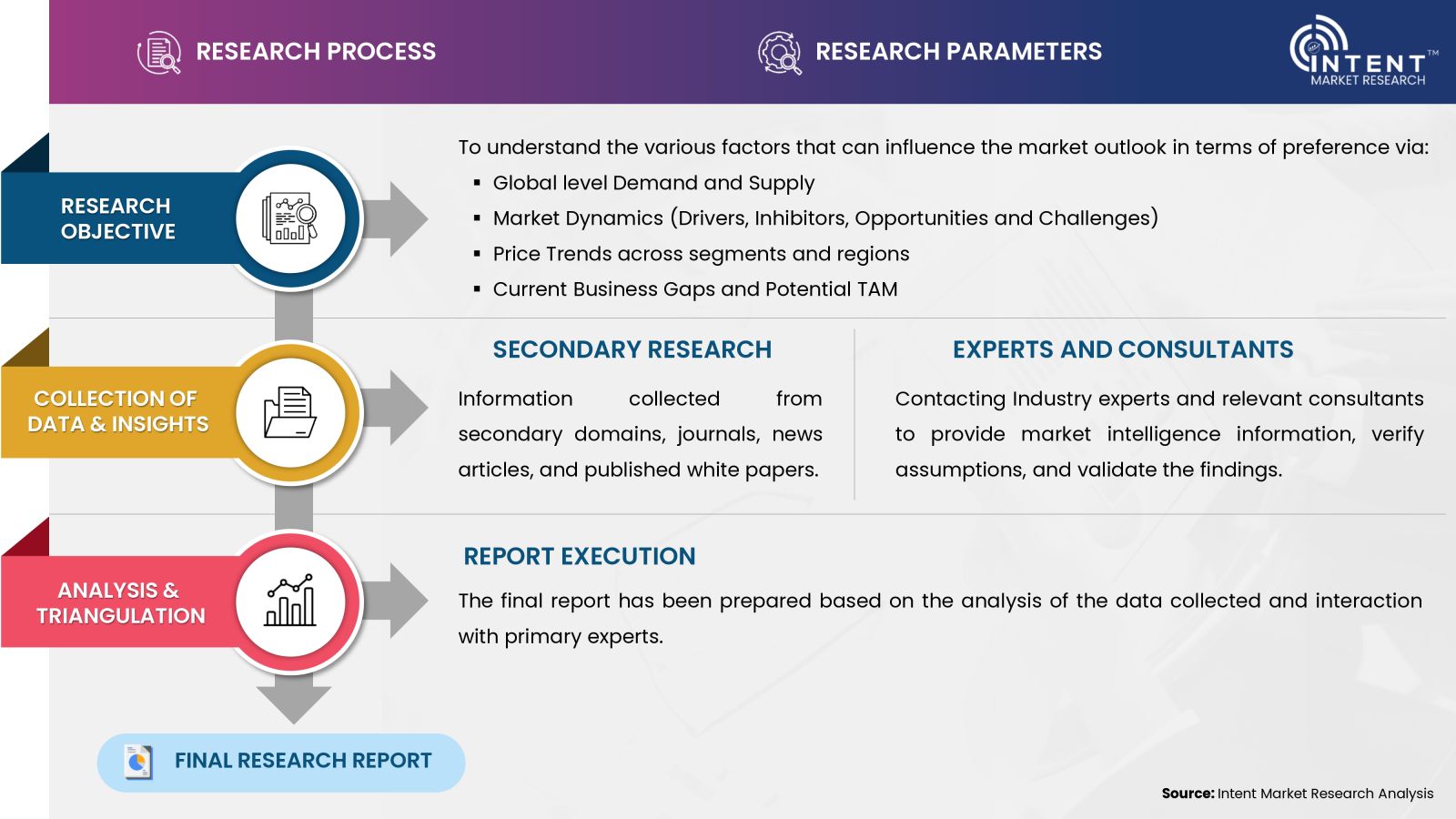
- Secondary Research Approach: During the initial phase of the research process, we acquire and accumulate extensive data continuously. This data is carefully filtered and validated through a variety of secondary sources.
- Primary Research Approach: Following the consolidation of data gathered through secondary research, we initiate a validation process to verify all the market numbers, and assumptions and validate the findings by engaging with subject matter experts.
Data Collection, Analysis and Interpretation:
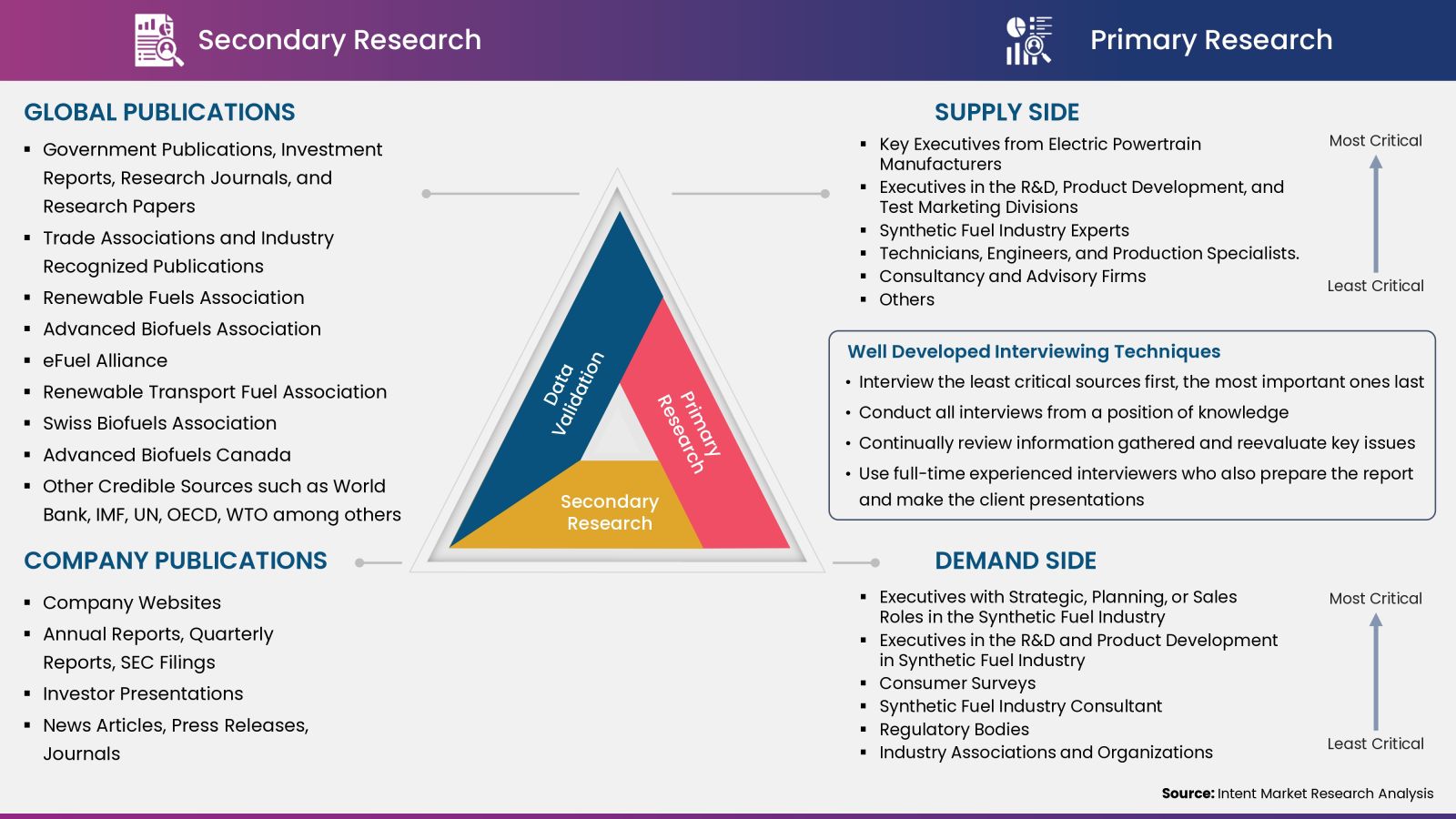
Research Methodology
Our market research methodology utilizes both top-down and bottom-up approaches to segment and estimate quantitative aspects of the market. We also employ multi-perspective analysis, examining the market from distinct viewpoints.
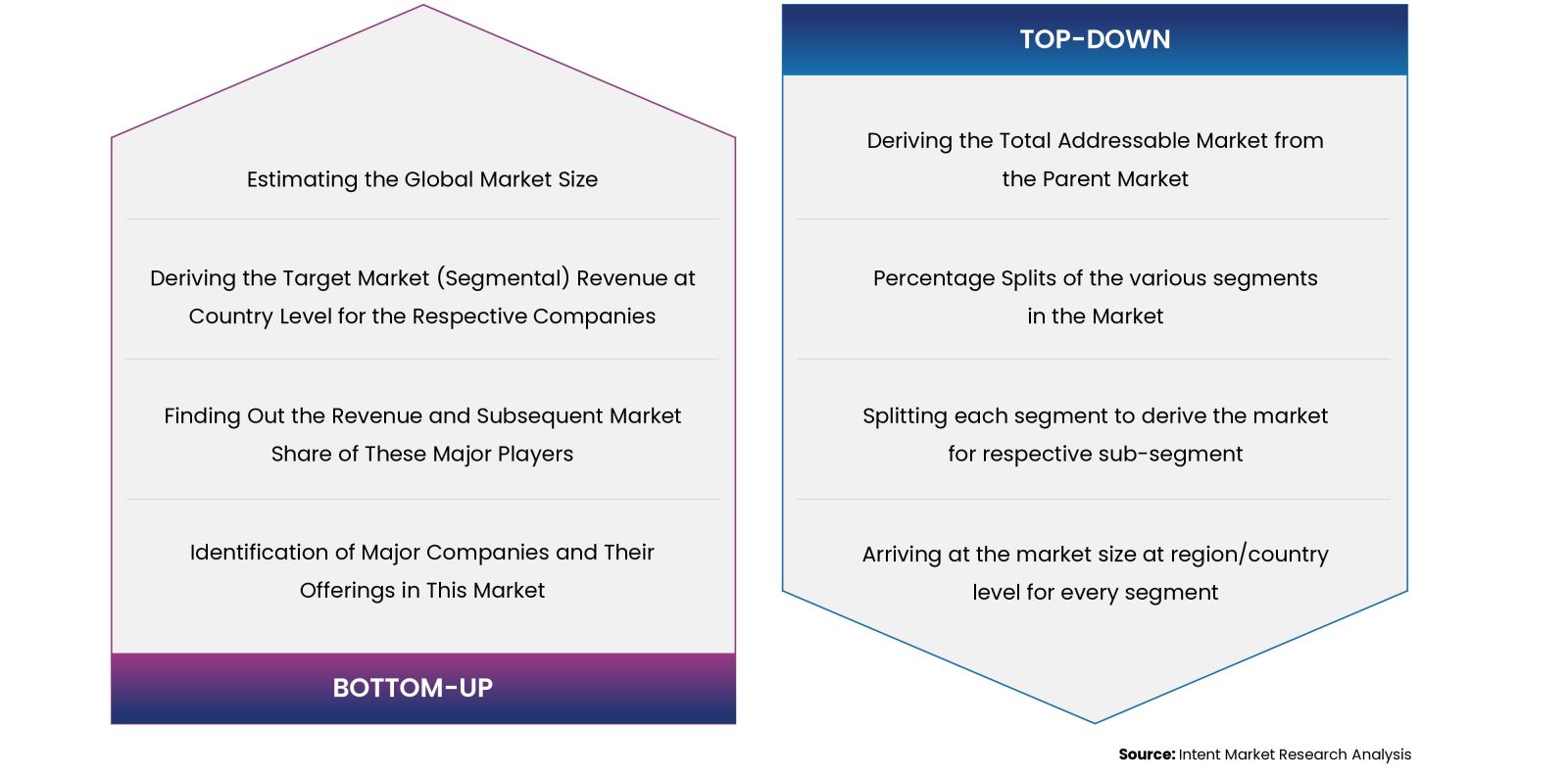
.jpeg)
